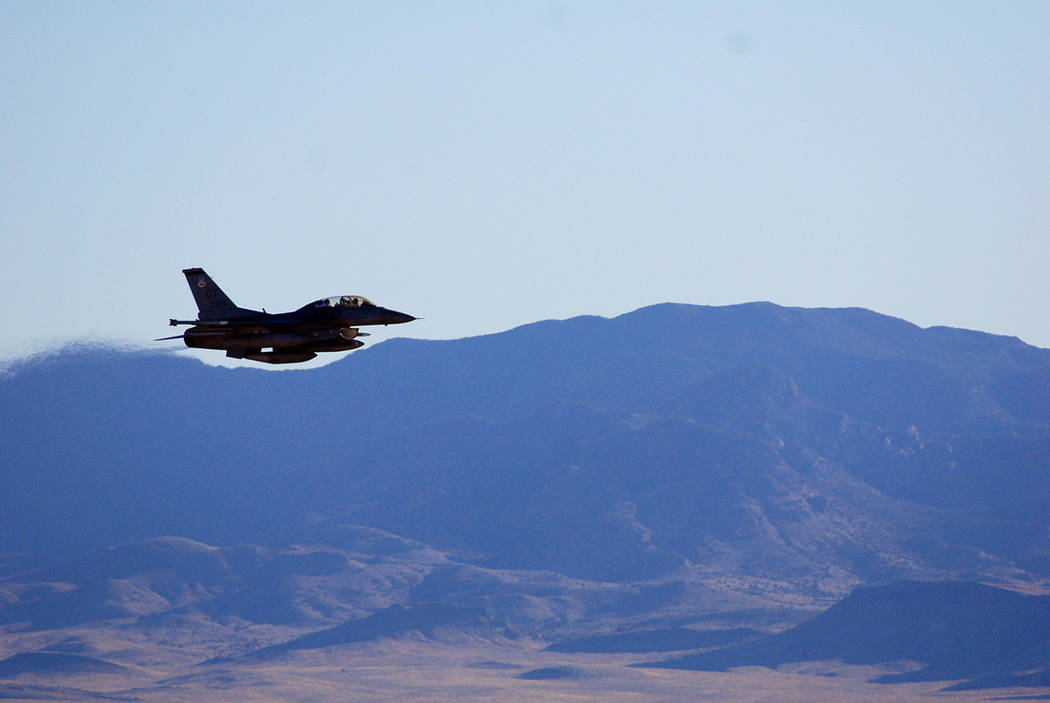Tonopah Test Range plans more than $12M in upgrades
Tonopah Test Range has recently received several updates to its telemetry system, and more renovations are on the way, officials said.
Telemetry stations gather radio frequency emissions from mock weapons being tested or from the airplanes that carry them, officials said. Tonopah has other instruments, including optical tracking telescopes and radars, that follow a test unit during flight.
Tonopah Test Range Manager Brian Adkins said Tonopah Test Range has modernized the telemetry sensors, recording and encryption equipment to meet its mission needs.
Officials integrated the fiber-optic network with its equipment and performed operational testing on these systems. The upgrades were completed as part of a greater recapitalization concept.
“The newer equipment certainly augments and supplements our legacy equipment,” Adkins said. “There have been many efforts and initiatives undertaken at TTR to enhance and modernize not only technical equipment, but facilities and infrastructure as well.”
Greg Wolf, deputy director at the Office of Public Affairs at the National Nuclear Security Administration U.S. Department of Energy, said that over the past two years, $891,000 was invested to upgrade the Tonopah Test Range.
“Specifically, the range modernized the telemetry sensors, recording and encryption equipment to meet mission needs, for a cost of $287,000. The remaining $604,000 was invested in fiber-optic system upgrades to integrate the new equipment,” Wolf said.
The Tonopah Test Range is a high priority for National Nuclear Security Administration, as it is the only dedicated flight test range.
As such, it rests on the critical path for developmental flight tests required to deliver future weapon systems, while supporting legacy stockpile surveillance, assessment and certification, Wolf said.
“These upgrades are crucial to improving range operations and data collection by replacing legacy, 30-to-50-year-old systems with commercial off-the-shelf technology, ensuring the range can sustain the operational rate required for current and future weapon development and stockpile needs,” Wolf said.
Tonopah Test Range is a restricted military test range located about 30 miles southeast of Tonopah. Built in 1957, it currently provides a space for programs that extend the life of the nation’s aging nuclear weapons arsenal, according to Sandia National Laboratories that operates Tonopah Test Range.
Currently in the works
Sandia is currently working on an in-house upgrade to its optical sensors that will allow for remote operation.
“Currently, the operator mans the mount in the field,” Adkins said. “When our remote conversion is done, they will control from a specifically designed operator’s console with digital feedback and will operate the system via a digital console and joystick. Operators will all be linked via headsets and be able to coordinate with the mission controller and each other.”
Adkins said the weather extremes can significantly affect electrical connections, as the blowing dust gets into crevices.
“We’ve even had some fiber-optic cables chewed through by small rodents, bringing a system to an immediate halt,” Adkins said.
Another major challenge is bridging interoperability gaps, he added.
“When you upgrade 30-to-50-year-old systems with some modern components you have to solve the problem on both sides of that component—taking a lot of design, and trial and error work,” Adkins said.
Wolf said that future upgrades to the Tonopah Test Range are currently pegged at over $12 million. The biggest portion of these costs is a $12 million remote sensor system. The remaining $200,000 will be split evenly between additional telemetry and the fiber-optic system.
For the past few years, officials added a number of fiber-optical networks and doubled the range’s telemetry capability to meet its mission requirements, as well as remote operations initiative for its sensor systems.
The test range also added new ability to pipe telemetry data during tests back to Sandia.
“We have had success with displaying telemetry data from our range back to our test engineers and other test partners in Albuquerque,” Adkins said. “This capability greatly enhances the agency’s ability back there to see what’s going on without having to travel all the way to the range.”
With time, Sandia expects near real-time, fully integrated communications telemetry, including video stream between Tonopah Test Range and Sandia National Laboratories in Albuquerque, New Mexico, officials said.
Contact reporter Daria Sokolova at dsokolova@pvtimes.com. On Twitter: @dariasokolova77


















